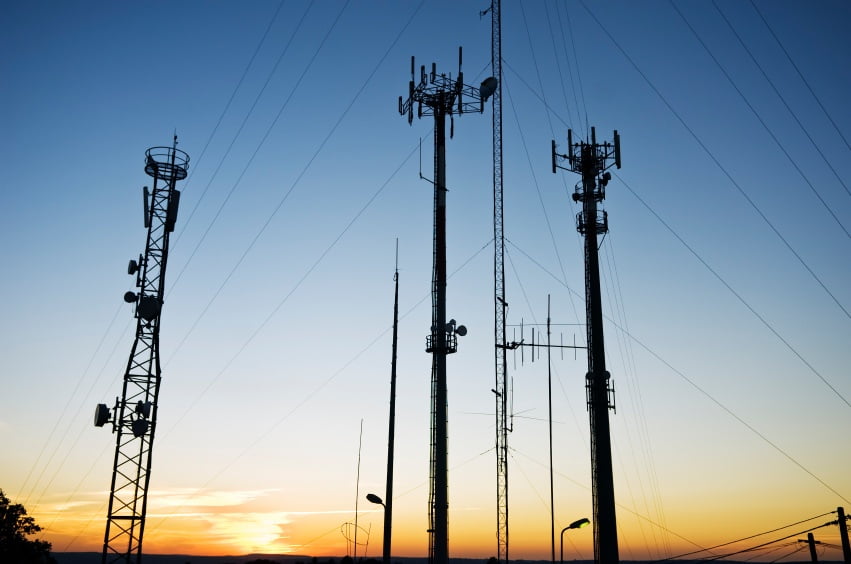Telecom Electrical Enclosure Cooling: Back to Basics

Today’s telecommunications networks are essential for the Internet, cell phones, and industrial control and communications, in addition to radio and television. As bandwidth and power demands increase, the electrical component densities in telecom equipment, such as transmitters and receivers, increase at similar rates.
Outside plant enclosures for telecommunications, including cell tower base stations, control cabinets, power cabinets, and distribution stations, must be kept within the maximum recommended operating temperature of critical equipment to insure reliable communications links.
But the increased heat dissipation from the equipment itself, in addition to solar heat absorbed by outdoor enclosures—make traditional enclosure cooling methods, such as fans or natural convection, ineffective.
Widely distributed and remote locations, challenging conditions, and extreme climates call for state-of-the-art methods for cost-efficient cooling of telecom enclosures. In addition, enclosures located outdoors demand a watertight seal to keep precipitation and contaminants, such as dust and humidity, from entering and damaging electrical equipment.
NEMA Type 4 or 4X
To meet these challenges, most outside telecom applications will require a NEMA type 4 or 4X enclosure.
NEMA Type 4 enclosures are rated for either indoor or outdoor use and provide a degree of protection against falling dirt and windblown dust, as well as rain, sleet, snow, splashing water, or direct water sprays, and against ice forming on the outside of the enclosure.
NEMA Type 4X enclosures are also rated for either indoor or outdoor use and provide all the same protections as NEMA 4 enclosures, plus an additional level of protection against corrosion from vapors, salt, or other chemicals.
Closed Loop Cooling
Both NEMA 4 and NEMA 4X enclosures require closed-loop cooling systems rather than fan or forced convection systems. In a closed-loop system, ambient air never reaches the interior of the enclosure, but instead heat is removed from the sealed enclosure.
Two types of closed loop cooling systems are available: air conditioners and air to air heat exchangers. For an air conditioner, the heated air from the electrical enclosure is pumped through an evaporator coil that cools it, and is then returned to the enclosure without ever encountering outside air. The refrigerant inside the coil absorbs the heat and expels it via a condenser coil.
A similar method is used in an air to air heat exchanger, except the heated enclosure air is passed over the evaporator side of a passive heat pipe which has extremely high thermal conductivity. Heat exchangers are a more cost efficient method of cooling an enclosure than air conditioners, but they can only be used in situations where the ambient temperature remains below the maximum operating temperature of the equipment.
Cooling System Size
The correct size of a telecom enclosure cooling system will depend on several factors. The enclosure heat load is a combination of the heat generated by each of the electrical components, and heat transferred into the enclosure from sun exposure. As long as the interior temperature is higher than the ambient temperature, a certain amount of heat will also be conducted out of the enclosure walls through radiative heat transfer.
To calculate the required cooling capacity for an enclosure, first the difference between the maximum allowable internal temperature and the maximum ambient air temperature, or ΔT, must be calculated. If ΔT is negative, an enclosure air conditioner, rather than an air to air heat exchanger, will be required.
For an air to air heat exchanger, the size of the system will be determined by the combined internal heat load of the components, in watts, minus the amount of heat conducted through the enclosure walls, divided by ΔT. Heat exchanger capacity is expressed in watts/°F.
For an enclosure air conditioner, the cooling capacity must be equal to, or greater than, the total heat load, and is expressed in BTU/hr.
An online enclosure temperature management calculator can be used to assist in selecting the proper cooling system and determine the appropriate size of an enclosure.
48 VDC option
Many telecom cabinets are located in remote sites, requiring them to operate on battery, solar, or wind power. In these cases, a cooling solution operating on DC voltage makes a lot of sense. Some manufacturers offer 48 VDC powered cooling systems with the same features as AC powered units.
Remote security
For remote enclosures, security is a requirement. Rather than a programmable digital controller located on the face of an enclosure air conditioner where it could be vandalized, some manufacturers offer an option for the controller to be mounted inside the locked electrical enclosure itself.
Remote monitoring
Remote monitoring is essential for remotely located telecom enclosures to ensure that vital equipment is protected from excess temperatures 24/7. Some enclosure air conditioners come with an optional remote control, monitoring, and alarm system for the cooling and heating functions of the air conditioner. This can be done using a personal computer (PC) connected to an Ethernet network.
Thermal Edge enclosure air conditioners are manufactured to meet the requirements and specifications of applications in the telecom industries. Thermal Edge enclosure air conditioners conform to UL, cUL, and CE requirements and come in NEMA type 4 or 4X.
Contact the experts at Thermal Edge for help in designing the optimal cooling system for your telecom enclosure.

